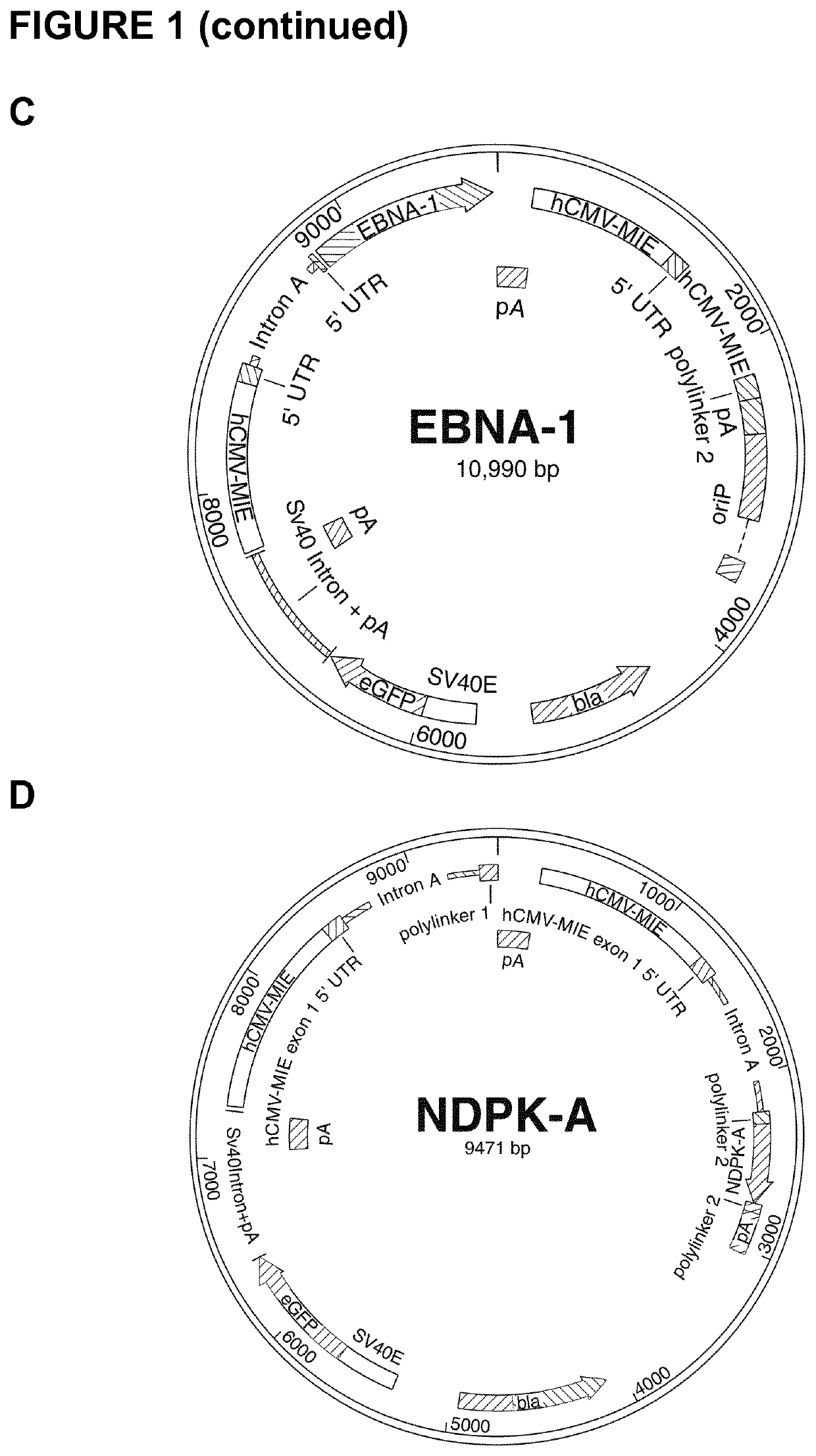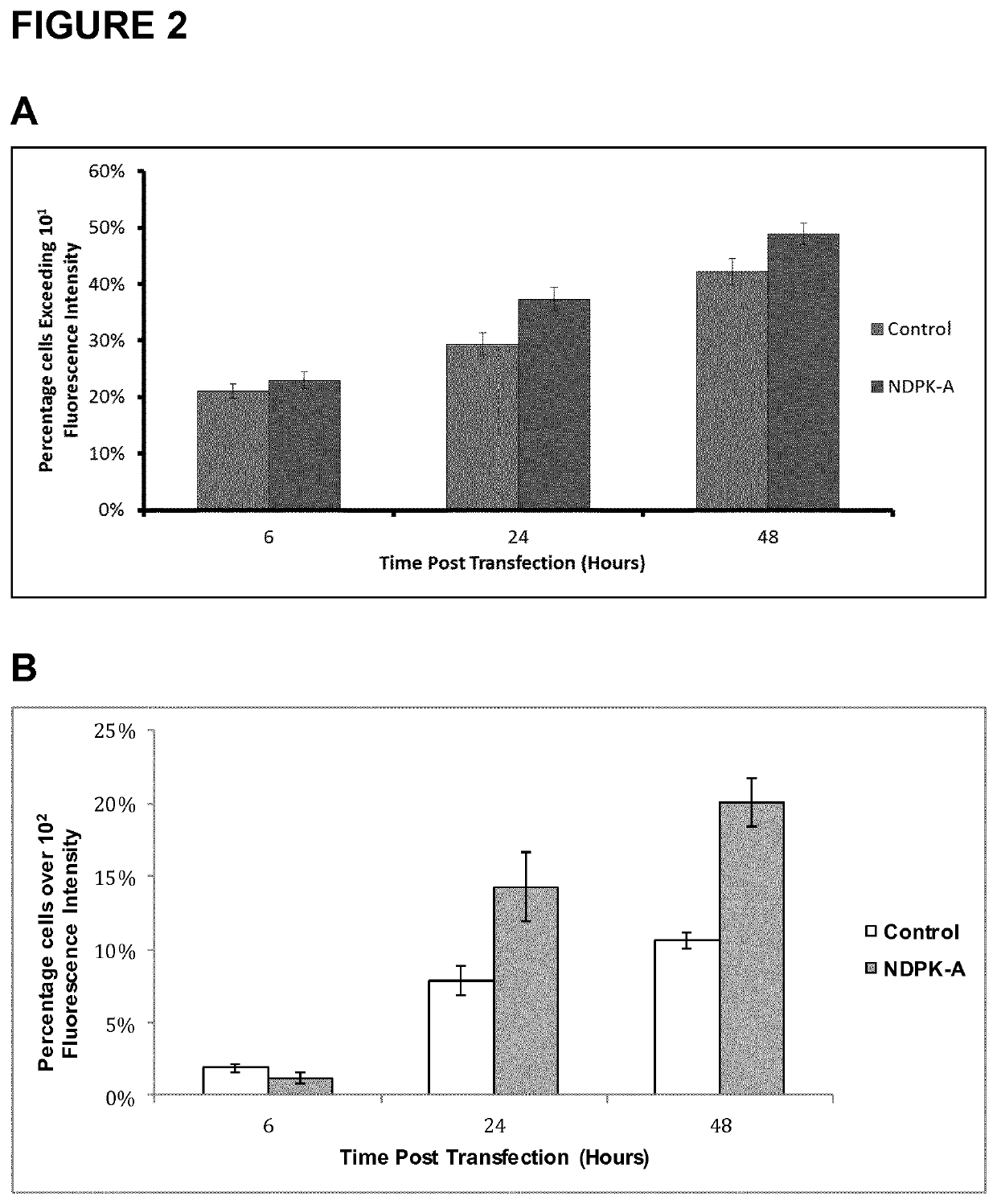Mammalian expression system
a technology of expression system and mammalian, applied in the field of mammalian expression system, can solve the problems of unsatisfactory cell line generation, difficult culture of lymphoid cells at an industrial scale, and high product yield, and achieve the effects of enhancing dna delivery to the nucleus, reducing the number of cells expressing, and promoting dna maintenan
- Summary
- Abstract
- Description
- Claims
- Application Information
AI Technical Summary
Benefits of technology
Problems solved by technology
Method used
Image
Examples
example 1
Materials and Methods
[0166]1.1 Vector Construction
[0167]For construction of the control vector utilized in transient experimentation, the eGFP gene was amplified via PCR using fwd-eGFP and rev-eGFP primers (shown in Table 1) and the peGFP-N1 vector (Clontech Laboratories Inc., Mountain View, Calif., USA) as a template. Subsequently, NheI and BgIII restriction enzymes were used to insert the amplified fragment such that the eGFP is located downstream of an SV40 promoter allowing for efficient expression of the gene (FIG. 1A). The minimal OriP DNA-binding units were synthesized commercially (by Geneart) and sub-cloned into the eGFP vector using BamHI and SaII enzymes (FIG. 1B).The truncated EBNA-1 gene was amplified using the fwd-EBNA and rev-EBNA primers. XbaI and AgeI restriction enzymes were used to insert the gene upstream of the first hCMV-MIE promoter in the previously generated eGFP vector. In addition, the minimal OriP units (i.e., the ‘Family of Repeats’ DNA-binding site for ...
example 2
Effect of NDPK-A Gene Expression on Transfection Efficacy in CHO Cells
[0179]In order to evaluate the effect of NDPK-A (NME1) on transient gene expression, respective expression vectors encompassing the NDPK-A nucleic acid sequence were transiently transfected into CHOK1SV, CHOK1SV GS, and CHO9B (data not shown) suspension cell lines by means of electroporation, respectively. The enhanced green fluorescent gene was used as selection marker. Analysis was subsequently undertaken using flow cytometry to identify both the percentage of cells expressing eGFP and the amount expressing eGFP beyond a pre-determined threshold. Representative experimental results are shown in FIG. 2, FIG. 4, FIG. 6, and FIG. 7, respectively.
[0180]In all three CHO cell lines analyzed (some data not shown), the percentage of cells that exceed a fluorescence intensity threshold upon transient transfection was substantially enhanced with concomitant expression of the NDPK-A nucleic acid sequence, which suggests an...
example 3
EBNA-1 and OriP Induced Extrachromosomal Maintenance in CHO Cells
[0181]The effect of EBNA-1 and OriP elements (i.e., the ‘Family of Repeats’ DNA-binding site for EBNA-1 and the ‘Dyad Symmetry’ DNA-binding site for EBNA-1) on transient transfection, and in particular on the induction of extrachromosomal maintenance of the transfected expression vectors, was analyzed in CHOK1SV, CHOK1SV GS, and CHO9B suspension cell lines, respectively. A vector encoding the eGFP gene was used as a negative control and vectors encoding an EBNA-1 nucleic acid sequence and a combination of EBNA-1 and the OriP sequences, respectively, were transiently transfected via electroporation. The percentage of cells that exceeded a fluorescence intensity threshold were measured by means of flow cytometry at various time points post transfection as an indication of induced extrachromosomal maintenance. Representative experimental results are shown in FIG. 3, FIG. 4, FIG. 6, FIG. 7, and FIG. 8, respectively.
[0182]I...
PUM
| Property | Measurement | Unit |
|---|---|---|
| nucleic acid | aaaaa | aaaaa |
| nucleic acid sequence | aaaaa | aaaaa |
| density | aaaaa | aaaaa |
Abstract
Description
Claims
Application Information
 Login to View More
Login to View More - R&D
- Intellectual Property
- Life Sciences
- Materials
- Tech Scout
- Unparalleled Data Quality
- Higher Quality Content
- 60% Fewer Hallucinations
Browse by: Latest US Patents, China's latest patents, Technical Efficacy Thesaurus, Application Domain, Technology Topic, Popular Technical Reports.
© 2025 PatSnap. All rights reserved.Legal|Privacy policy|Modern Slavery Act Transparency Statement|Sitemap|About US| Contact US: help@patsnap.com



